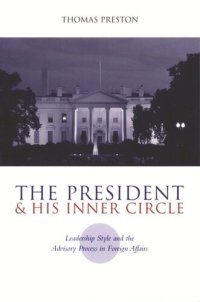
Ebook: The President and His Inner Circle: Leadership Style and the Advisory Process in Foreign Policy Making
Author: Thomas Preston
- Year: 2001
- Publisher: Columbia University Press
- Language: English
- pdf
Using M. G. Hermann's Personality Assessment-at-a-Distance (PAD) profiling technique as well as exhaustive archival research and interviews with former advisers, the author develops a leadership style typology. He then compares his model's expectations against the actual policy record, using six foreign policy episodes.
Few would argue that presidential policies and performance would have been the same whether John F. Kennedy or Richard Nixon became president in 1960, or if Jimmy Carter instead of Ronald Reagan had won the White House in 1980. Indeed, in recent elections, the character, prior policy experience, or personalities of candidates have played an increasing role in our assessments of their "fit" for the Oval Office. Further, these same characteristics are often used to explain an administration's success or failure in policy making. Obviously, who the president is—and what he is like—matters.
This book, a new approach to the study of the personal presidency, links the characteristics of six modern American presidents—their personalities and their prior policy-making experience—to their leadership styles, advisory arrangements, and decision making in the White House. Thomas Preston uses M. G. Hermann's Personality Assessment-at-a-Distance (PAD) profiling technique, as well as exhaustive archival research and interviews with former advisors, to develop a leadership style typology. He then compares his model's expectations against the actual policy record of six past presidents, using foreign policy episodes: Korea (1950) for Truman, Dien Bien Phu (1954) for Eisenhower, Cuba (1962) for Kennedy, Vietnam (1967-68) for Johnson, the Gulf War (1990-91) for Bush, and North Korea/Haiti/Bosnia (1994-95) for Clinton.